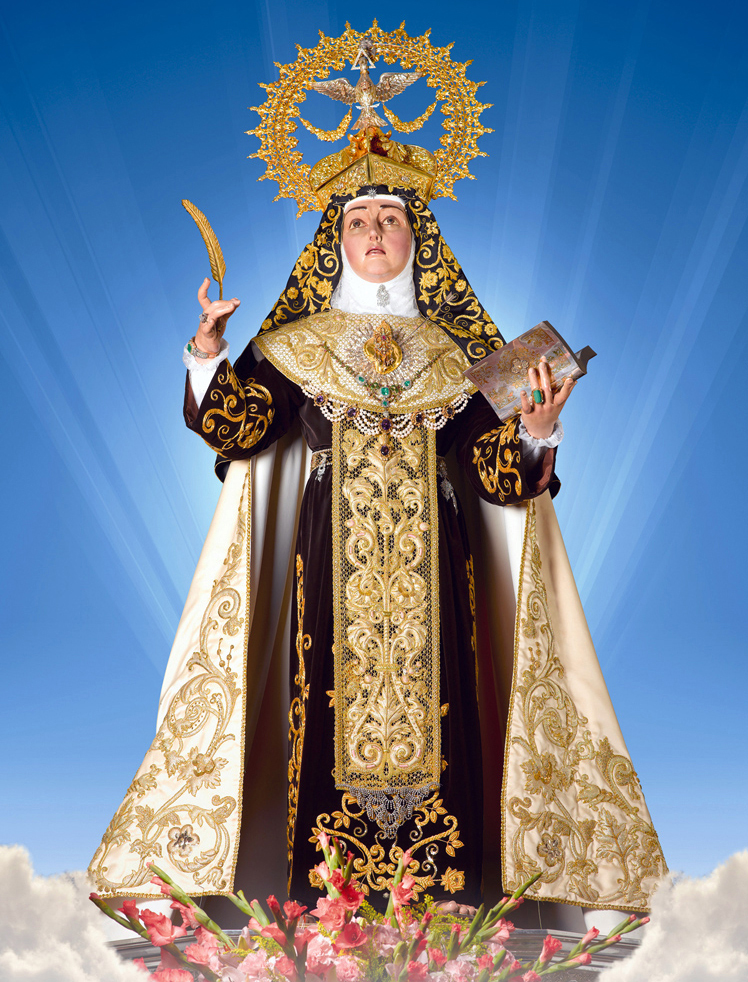
Audio Player
Messages given by Crowned Saint Teresa of Jesus to Clemente Domínguez y Gómez, today Pope Saint Gregory XVII, the Very Great
 4th of January 1970
4th of January 1970
(Sacred Place of the Lentisco in El Palmar de Troya. Apparitions and Messages to Clemente Domínguez:)
Saint Teresa of Jesus
“I intercede for my beloved Spain, but you should invoke my daughter Teresa, predestined by the Eternal Father for the salvation of the world. I love you all.” (One of those present said that she was the greatest woman after the Virgin Mary, and Saint Teresa replied:) “No, child; that is to human eyes. God disposes things wisely. You have forgotten great saints. We all enjoy great harmony in the Heavenly Court: your Apostle Saint James, King Saint Ferdinand, Saint Albert the Great, Saint Martin de Porres, who holds a pre-eminent place in Heaven thanks to his humility and the world’s disregard for him. Your Saint Clement, Pope and Martyr, who died in defence of the Truth. Seville should be grateful to Saint Clement. My children: obviously Jesus Christ’s Family is over and above all the Saints.
My son: do not forget to beg the mediation of Padre Pio. You should pray to speed up his canonization. It is my wish, and shared by the will of the Virgin Mary, that after his canonization he have a privileged altar in the future Chapel of this Sacred Place, so that he may protect you during the days of darkness.”
28th of September 1970
(Sacred Place of the Lentisco in El Palmar de Troya. The Exalted Reformatrix Saint Teresa of Jesus appeared to Clemente Domínguez. After speaking to him on the Doctrine of the Resurrection of Saint Joseph and his Assumption Body and Soul into Heaven, she concluded the Message saying:)
Saint Teresa of Jesus
“My children: I ask you all to be very devoted to Saint Joseph, as I was. You should imitate his virtues. He always intercedes for you. Always petition through the intercession of Saint Joseph, as He has great power before Mary’s throne. Saint Joseph has great glory, very great; and all who imitate him shall have great glory in Heaven. I bless you.” (The seer had a vision of Saint Joseph in Heaven, full of glory.)
Apostolic Journey by Clemente Domínguez y Gómez through Spain
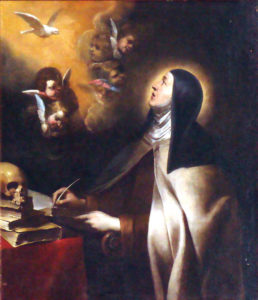 3rd of August 1971
3rd of August 1971
(Alba de Tormes, Salamanca, Spain. Chapel of the Convent of Discalced Carmelite Nuns. Saint Teresa of Jesus appeared to Clemente Domínguez and gave him the following Message:)
Saint Teresa of Jesus
“My dear son: Good Jesus, Lord of lords, King of kings, Lord of Hosts, Delight of the Blessed, Mediator between the Father and mankind, Servant of the poor, Relief of the Dying, has sent you to this place where my poor flesh reposes awaiting the resurrection, so that you receive the palpitations of my heart, my impulse, my spirit, my strength, and continue firm amid adversities, unfavourable conditions, mortifications and the scorn of men, proper to those who follow Jesus the Friend.
My son: the more you suffer combats, insults, mockery, infernal attacks, upsets from your brethren, desertion by those you love most, then can you say: this is God’s Work! For Jesus was combated, insulted, offended, buffeted, treated as a blasphemer and accused of conspiring against Caesar; He was sentenced to Death on the Cross, abandoned by His dearest friends, His own disciples; but on the third day He rose glorious from the dead. If you want to rise with Christ, accept the Cross. If you want to rise with Satan, wallow in the pleasures of this world.
I WAS VERY BADLY TREATED BY MY FELLOW CITIZENS, BY MY BRETHEREN IN RELIGION AND FRIGHTFULLY UPBRAIDED BY THE CHURCH HEIRARCHY. My journeys were considered as the vagaries of a restless woman; the commands of my Jesus were seen as impositions of mine opposed to Pauline Teaching; I was at the point of being sentenced by the Tribunal of the Inquisition. BUT NONE COULD PREVAIL AGAINST ME, NEITHER LAYPEOPLE, NOR MINISTERS, NOR BISHOPS, NOR CARDINALS, FOR THE TIME CAME WHEN I HAD TO DISOBEY MY EARTHLY SUPERIORS AND FOLLOW THE DICTATES OF THE GREAT LAWGIVER, JESUS CHRIST, MY SUPREME DIRECTOR, TO WHOM I WAS BOUND TO SUBMIT UNDER PAIN OF ETERNAL DAMNATION.
Had I disobeyed Jesus and obeyed my earthly Superiors, the magnificent Carmelite Reform, which did so much good to the Church and the world, would not have been accomplished. Subsequently, when my body was in the grave, Holy Mother Church raised me to the Altars, and bestowed innumerable titles upon me, crowned now with that of Doctress of the Church. My submission to the King of kings brought all this about.
My son: obey Jesus, whenever you are sure that it is the sweet voice of the Son of God and Brother of men that you hear. Beware of false obedience to the Church Hierarchy, for when God’s Rights and men’s salvation are at stake, there is no power on earth but that of Him who has received all power from the Father. Finally, I ask all who are dedicated to publishing the wonders that Jesus and Mary are performing around the world, to have recourse to My patronage and they will acquire an inspired pen. I bless you.”
 10th of March 1977
10th of March 1977
(Seville. Mother House. Time: 2.25. During Worship in the Chapel, Our Lord Jesus Christ appeared to Bishop Father Ferdinand. A few minutes later, Saint Teresa of Jesus appeared to him. The Lord said: “Here among you is the Reformatrix of Carmel, Teresa of Ávila, your Protectress.” Saint Teresa gave Father Ferdinand the following Message:)
Saint Teresa of Ávila
“How happy I am with my Carmelites of the Holy Face! And if you knew that, when I was on earth, my beloved Spouse Jesus Christ told me that one day, in Apocalyptic Times, the Order of Carmelites of the Holy Face would be founded! And that it would be an outstanding Branch of my Reform. What graces shall come upon you in the very near future, very near! Very near indeed! That is why the Lord has increased your prayers and penances, to prepare you for great events in the Church, events in which you will play a very important role.
O my dear children, Carmelites of the Holy Face! How much I love you! For where is the spirit of the Reform now? What is left of the spirit of the Reform in today’s Carmelites in the world? They are joining the calced and changing the whole Reform, on their way to progressivism. What grief to contemplate the Order which cost me so much suffering to reform! BUT YOU CONSERVE THE SPIRIT OF THAT REFORM. THE SPIRIT OF PRAYER AND PENANCE. THE SPIRIT OF SUBMISSION TO GOD’S WILL. YOU ARE FIGHTING AGAINST THE WICKED HEIRARCHY TODAY GOVERNING THE HOLY CHURCH. I know about these things! I had to struggle against wicked Bishops, wicked Superiors, wicked Nuncios, and so forth. But the wicked of today are worse than those of that time. All the prayer and penance that you do is little to make reparation to God for so many offences, so many affronts.
How many Carmelites today give bad example by their ruinous progressivism! How many Bishops in the official Church have abandoned wholesome Doctrine and joined marxism, freemasonry and heresy! You are the little flock on which the Good Shepherd, Jesus Christ, relies. Do much prayer and penance, much prayer and penance, much prayer and penance. The great cataclysm to fall upon mankind is now at hand.
O CARMELITES OF THE HOLY FACE! YOU ARE THE LUMINOUS STARS OF THE CHURCH AMID THE RAMPANT CONFUSION. But you must become more perfect. You still have many defects. And this perfection is attained, more than by books, more than by reading, by prayer and penance and holy obedience to your Father General.” (After giving some instructions on prayers, Saint Teresa continues:) “What graces will you receive! What graces! They will be innumerable and are very near at hand. It is worth your while to do prayer and penance so as to receive so many graces that will astonish the world. Some graces not granted to many other Saints. What wonders there will be for you in the Order of Carmelites of the Holy Face! And now, obeying your Reformatrix, continue with the prayers, after my blessing. I bless you.” (Saint Teresa places her Heart in Father Ferdinand’s hand. The seer said: “And how can this Transverberated Heart be here in my hand and kept in Castile as well?” Saint Teresa replied:) “My son: divine Mysteries. Don’t be so curious. You will know everything in due course. Now, by desire of the Most Holy Virgin Mary, embed this Heart in yours!” (The seer pressed the Mystical Doctress’s Heart firmly to his own heart.)
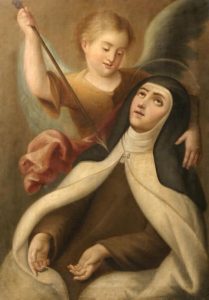
6th of August 1978
Saint Teresa of Ávila
“Dear children: here the Reformatrix of Carmel speaks to you. Congratulations to you, since your Founder and Father General has been raised to the office of Vicar of Christ. This afternoon, nature itself announced the appointment with the flight of the butterfly. This was not a chance happening. It was a prophetic announcement for the humble and simple of heart.” (Explanation: shortly after learning of the death of Pope Paul VI, several friars accompanying the Supreme Pontiff Gregory XVII were at the door of his cell in Santa Fe de Bogotá. We saw a large butterfly enter from the street by the stairway, and fluttering around it perched on the very centre of the lintel of the door to his cell. We called several others, including our nuns who were in the Chapel, to witness the event. Shortly afterwards the butterfly entered His Holiness’ cell. We all saw a clear indication, a sign that Paul VI’s successor was to be found there. The butterfly was caught and kept. Saint Teresa goes on to say:) “From now on, the Mother General, Mother Teresa, becomes the Cofoundress, together with Father General, of the feminine Branch. She is the Cofoundress. I bless you.”

4th of January 1970
(Sacred Place of the Lentisco in El Palmar de Troya. Apparitions and Messages to Clemente Domínguez:)
Saint Teresa of Jesus
“I intercede for my beloved Spain, but you should invoke my daughter Teresa, predestined by the Eternal Father for the salvation of the world. I love you all.” (One of those present said that she was the greatest woman after the Virgin Mary, and Saint Teresa replied:) “No, child; that is to human eyes. God disposes things wisely. You have forgotten great saints. We all enjoy great harmony in the Heavenly Court: your Apostle Saint James, King Saint Ferdinand, Saint Albert the Great, Saint Martin de Porres, who holds a pre-eminent place in Heaven thanks to his humility and the world’s disregard for him. Your Saint Clement, Pope and Martyr, who died in defence of the Truth. Seville should be grateful to Saint Clement. My children: obviously Jesus Christ’s Family is over and above all the Saints.
My son: do not forget to beg the mediation of Padre Pio. You should pray to speed up his canonization. It is my wish, and shared by the will of the Virgin Mary, that after his canonization he have a privileged altar in the future Chapel of this Sacred Place, so that he may protect you during the days of darkness.”
28th of September 1970
(Sacred Place of the Lentisco in El Palmar de Troya. The Exalted Reformatrix Saint Teresa of Jesus appeared to Clemente Domínguez. After speaking to him on the Doctrine of the Resurrection of Saint Joseph and his Assumption Body and Soul into Heaven, she concluded the Message saying:)
Saint Teresa of Jesus
“My children: I ask you all to be very devoted to Saint Joseph, as I was. You should imitate his virtues. He always intercedes for you. Always petition through the intercession of Saint Joseph, as He has great power before Mary’s throne. Saint Joseph has great glory, very great; and all who imitate him shall have great glory in Heaven. I bless you.” (The seer had a vision of Saint Joseph in Heaven, full of glory.)
Apostolic Journey by Clemente Domínguez y Gómez through Spain

3rd of August 1971
(Alba de Tormes, Salamanca, Spain. Chapel of the Convent of Discalced Carmelite Nuns. Saint Teresa of Jesus appeared to Clemente Domínguez and gave him the following Message:)
Saint Teresa of Jesus
“My dear son: Good Jesus, Lord of lords, King of kings, Lord of Hosts, Delight of the Blessed, Mediator between the Father and mankind, Servant of the poor, Relief of the Dying, has sent you to this place where my poor flesh reposes awaiting the resurrection, so that you receive the palpitations of my heart, my impulse, my spirit, my strength, and continue firm amid adversities, unfavourable conditions, mortifications and the scorn of men, proper to those who follow Jesus the Friend.
My son: the more you suffer combats, insults, mockery, infernal attacks, upsets from your brethren, desertion by those you love most, then can you say: this is God’s Work! For Jesus was combated, insulted, offended, buffeted, treated as a blasphemer and accused of conspiring against Caesar; He was sentenced to Death on the Cross, abandoned by His dearest friends, His own disciples; but on the third day He rose glorious from the dead. If you want to rise with Christ, accept the Cross. If you want to rise with Satan, wallow in the pleasures of this world.
I WAS VERY BADLY TREATED BY MY FELLOW CITIZENS, BY MY BRETHEREN IN RELIGION AND FRIGHTFULLY UPBRAIDED BY THE CHURCH HEIRARCHY. My journeys were considered as the vagaries of a restless woman; the commands of my Jesus were seen as impositions of mine opposed to Pauline Teaching; I was at the point of being sentenced by the Tribunal of the Inquisition. BUT NONE COULD PREVAIL AGAINST ME, NEITHER LAYPEOPLE, NOR MINISTERS, NOR BISHOPS, NOR CARDINALS, FOR THE TIME CAME WHEN I HAD TO DISOBEY MY EARTHLY SUPERIORS AND FOLLOW THE DICTATES OF THE GREAT LAWGIVER, JESUS CHRIST, MY SUPREME DIRECTOR, TO WHOM I WAS BOUND TO SUBMIT UNDER PAIN OF ETERNAL DAMNATION.
Had I disobeyed Jesus and obeyed my earthly Superiors, the magnificent Carmelite Reform, which did so much good to the Church and the world, would not have been accomplished. Subsequently, when my body was in the grave, Holy Mother Church raised me to the Altars, and bestowed innumerable titles upon me, crowned now with that of Doctress of the Church. My submission to the King of kings brought all this about.
My son: obey Jesus, whenever you are sure that it is the sweet voice of the Son of God and Brother of men that you hear. Beware of false obedience to the Church Hierarchy, for when God’s Rights and men’s salvation are at stake, there is no power on earth but that of Him who has received all power from the Father. Finally, I ask all who are dedicated to publishing the wonders that Jesus and Mary are performing around the world, to have recourse to My patronage and they will acquire an inspired pen. I bless you.”

10th of March 1977
(Seville. Mother House. Time: 2.25. During Worship in the Chapel, Our Lord Jesus Christ appeared to Bishop Father Ferdinand. A few minutes later, Saint Teresa of Jesus appeared to him. The Lord said: “Here among you is the Reformatrix of Carmel, Teresa of Ávila, your Protectress.” Saint Teresa gave Father Ferdinand the following Message:)
Saint Teresa of Ávila
“How happy I am with my Carmelites of the Holy Face! And if you knew that, when I was on earth, my beloved Spouse Jesus Christ told me that one day, in Apocalyptic Times, the Order of Carmelites of the Holy Face would be founded! And that it would be an outstanding Branch of my Reform. What graces shall come upon you in the very near future, very near! Very near indeed! That is why the Lord has increased your prayers and penances, to prepare you for great events in the Church, events in which you will play a very important role.
O my dear children, Carmelites of the Holy Face! How much I love you! For where is the spirit of the Reform now? What is left of the spirit of the Reform in today’s Carmelites in the world? They are joining the calced and changing the whole Reform, on their way to progressivism. What grief to contemplate the Order which cost me so much suffering to reform! BUT YOU CONSERVE THE SPIRIT OF THAT REFORM. THE SPIRIT OF PRAYER AND PENANCE. THE SPIRIT OF SUBMISSION TO GOD’S WILL. YOU ARE FIGHTING AGAINST THE WICKED HEIRARCHY TODAY GOVERNING THE HOLY CHURCH. I know about these things! I had to struggle against wicked Bishops, wicked Superiors, wicked Nuncios, and so forth. But the wicked of today are worse than those of that time. All the prayer and penance that you do is little to make reparation to God for so many offences, so many affronts.
How many Carmelites today give bad example by their ruinous progressivism! How many Bishops in the official Church have abandoned wholesome Doctrine and joined marxism, freemasonry and heresy! You are the little flock on which the Good Shepherd, Jesus Christ, relies. Do much prayer and penance, much prayer and penance, much prayer and penance. The great cataclysm to fall upon mankind is now at hand.
O CARMELITES OF THE HOLY FACE! YOU ARE THE LUMINOUS STARS OF THE CHURCH AMID THE RAMPANT CONFUSION. But you must become more perfect. You still have many defects. And this perfection is attained, more than by books, more than by reading, by prayer and penance and holy obedience to your Father General.” (After giving some instructions on prayers, Saint Teresa continues:) “What graces will you receive! What graces! They will be innumerable and are very near at hand. It is worth your while to do prayer and penance so as to receive so many graces that will astonish the world. Some graces not granted to many other Saints. What wonders there will be for you in the Order of Carmelites of the Holy Face! And now, obeying your Reformatrix, continue with the prayers, after my blessing. I bless you.” (Saint Teresa places her Heart in Father Ferdinand’s hand. The seer said: “And how can this Transverberated Heart be here in my hand and kept in Castile as well?” Saint Teresa replied:) “My son: divine Mysteries. Don’t be so curious. You will know everything in due course. Now, by desire of the Most Holy Virgin Mary, embed this Heart in yours!” (The seer pressed the Mystical Doctress’s Heart firmly to his own heart.)

6th of August 1978
Saint Teresa of Ávila
“Dear children: here the Reformatrix of Carmel speaks to you. Congratulations to you, since your Founder and Father General has been raised to the office of Vicar of Christ. This afternoon, nature itself announced the appointment with the flight of the butterfly. This was not a chance happening. It was a prophetic announcement for the humble and simple of heart.” (Explanation: shortly after learning of the death of Pope Paul VI, several friars accompanying the Supreme Pontiff Gregory XVII were at the door of his cell in Santa Fe de Bogotá. We saw a large butterfly enter from the street by the stairway, and fluttering around it perched on the very centre of the lintel of the door to his cell. We called several others, including our nuns who were in the Chapel, to witness the event. Shortly afterwards the butterfly entered His Holiness’ cell. We all saw a clear indication, a sign that Paul VI’s successor was to be found there. The butterfly was caught and kept. Saint Teresa goes on to say:) “From now on, the Mother General, Mother Teresa, becomes the Cofoundress, together with Father General, of the feminine Branch. She is the Cofoundress. I bless you.”
Biography of Crowned Saint Teresa of Jesus
4 of October
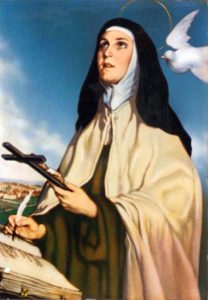
Nun. Foundress. Matriarch. Doctress. Exalted Mystic. Stigmatic. Spiritual Martyr. Confirmed in Grace. Reformatrix of Carmel and Illustrious Protectress of the Carmelites of the Holy Face.
In the world, Teresa de Cepeda y Ahumada, she was born in Ávila, Spain, on the 28th of March 1515. She was daughter of Saint Alphonse Sánchez de Cepeda and his second wife Saint Beatrice de Ahumada, to whose marriage ten children were born. She was baptized in the parish of Saint John in Ávila. Gifted with an active and determined temperament, at seven years of age, moved by her reading of the lives of the Saints, she convinced her brother Roderick to go off to muslim lands to suffer martyrdom for Christ. They were stopped by an uncle of theirs who took them back home. Nonetheless, on reaching adolescence, her pious childhood sentiments were somewhat dampened by reading books on chivalry which filled her imagination, and she took pleasure in finery and pastimes, though without offending God grievously.
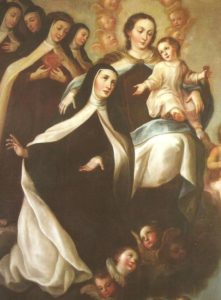
Following her mother’s death in 1528, she gave herself up into the arms of the Most Holy Virgin Mary as orphan. To withdraw her from the dangers of the world, and so that she might receive a pious education, in 1531 her father confided her as a boarder to the convent of the Augustinian Nuns of Holy Mary of Grace, in Ávila, where they took in well-to-do young ladies, who went there to make progress in the study of religion and in the practice of virtue. There she began to pray much and ask others to pray for her so that God might show her clearly the way by which she might best serve Him. Though she had no wish to be a Nun, she knew that human love did not last forever. She began to make up her mind to take the veil, but in an Order less austere than the Augustinians. Having discovered her vocation amid unspeakable struggles, after falling ill, in 1532 she left and spent some time in Hortigosa with her uncle Peter Sánchez de Cepeda, and in Castellanos de la Cañada with her sister Maria de Cepeda, who was married. Back in Ávila, following deep reflection, she revealed to her father her firm decision to become a nun, and he, though very virtuous, objected to being deprived of his favourite daughter. After a fierce interior struggle, very early on the 2nd of November 1535, at twenty years of age, Saint Teresa fled from home early in the morning and entered the Carmelite convent of the Incarnation, in Ávila, which she had previously visited several times, and in which religious life was very lax, since sadly the Carmelite Order was in decline, having set aside the primitive Rules. The Saint said regarding her decision: “When I left my father’s home, I do not believe that feelings will be stronger when I die, as it seemed to me that all my bones were out of joint…” Inside the convent there were Nuns who lived in opulence, including with maids, and others who lacked the necessities of life. Enclosure was practically nonexistent. On the 31st of October 1536, her father signed the dowry certificate for his daughter, and she took the habit on the 2nd of November that same year. In this regard she wrote: “By taking the habit, the Lord then gave me to understand how He favours those who make efforts to serve Him.” On the 3rd of November 1537 she made her religious profession. From then on she redoubled her demands upon herself, and gave herself up to great penances, amid spiritual struggles and dryness.
Her health deteriorated to such a degree that her father sent the best doctors in Ávila and its district to the Incarnation, but she went from bad to worse. Owing to her illnesses, in autumn 1538 she had to leave the Incarnation and stay at her family home for a long period. Though she tried caring for her health by other means, the illness worsened, to the point that on the 15th of August 1539, at night, she fell unconscious and remained so for three days. She was given up for dead, and a tomb was even prepared for her. Nonetheless, her father refused to admit his daughter’s demise and opposed her burial. Come to herself, she returned to the Incarnation very weak. In April 1542 she felt herself cured by Saint Joseph’s intercession. For long years Saint Teresa continued leading conventual life amid dryness and spiritual struggle. The parlours of the Incarnation were like worldly halls visited by ladies and gentlemen from the nobility. Saint Teresa, whose name had become well-known in Ávila, was the principal attraction, and received visits from many people and attended the parlour like the rest. On the 26th of December 1543, her father Saint Alphonse de Cepeda died, tended by his daughter. In 1554 a deep interior transformation took place in Saint Teresa, with a decisive commitment to God, on contemplating a devout image of the Wounded Christ.
 She says as follows: “I threw myself down beside Him shedding abundant tears, entreating Him to strengthen me once and for all so as not to offend Him. It seems to me that I then told Him that I would not rise up from there until He had done what I had begged of Him.” From then on she began to experience a profound change in her life. She avoided the parlour, and redoubled the constancy and ardour of her prayer. Mystical phenomena were frequent, the confessors of the Incarnation did not understand her, and some of the more notable even alarmed her by saying that the spiritual favours she said she received were only given to very virtuous persons, and that she should take care lest the devil deceive her. Christ appeared to her and said: “Fear not, My daughter, I am. I will not forsake you.” Visions of Christ recurred, and at the same time the love of God grew in her, a love so ardent as to be almost irresistible, as she herself wrote: “As He had promised me, His Majesty began to indicate more clearly that it was He, by a love for God growing so great that I did not know who was giving it to me, because it was highly supernatural, nor did I seek it. I felt myself dying from the desire to see God… truly it seemed to me that my soul was being torn out.” In the year 1557, the Jesuit Father Saint Francis Borgia, who was passing through Ávila, gave her wise counsels, and she became very relieved and comforted. On the 25th of January 1560, Saint Teresa received the grace of the Transverberation of the Heart, and therewith the extraordinary gift of Confirmation in Grace. She herself describes it:
She says as follows: “I threw myself down beside Him shedding abundant tears, entreating Him to strengthen me once and for all so as not to offend Him. It seems to me that I then told Him that I would not rise up from there until He had done what I had begged of Him.” From then on she began to experience a profound change in her life. She avoided the parlour, and redoubled the constancy and ardour of her prayer. Mystical phenomena were frequent, the confessors of the Incarnation did not understand her, and some of the more notable even alarmed her by saying that the spiritual favours she said she received were only given to very virtuous persons, and that she should take care lest the devil deceive her. Christ appeared to her and said: “Fear not, My daughter, I am. I will not forsake you.” Visions of Christ recurred, and at the same time the love of God grew in her, a love so ardent as to be almost irresistible, as she herself wrote: “As He had promised me, His Majesty began to indicate more clearly that it was He, by a love for God growing so great that I did not know who was giving it to me, because it was highly supernatural, nor did I seek it. I felt myself dying from the desire to see God… truly it seemed to me that my soul was being torn out.” In the year 1557, the Jesuit Father Saint Francis Borgia, who was passing through Ávila, gave her wise counsels, and she became very relieved and comforted. On the 25th of January 1560, Saint Teresa received the grace of the Transverberation of the Heart, and therewith the extraordinary gift of Confirmation in Grace. She herself describes it: 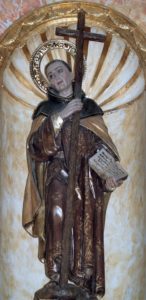 “I saw an Angel close beside me on the left side in bodily form… He was not tall, but short, remarkably beautiful, his countenance so flushed that he seemed one of the highest Angels… In his hands a long golden dart was to be seen, and at the tip of the dart-head seemed to have a little fire; it seemed to pierce my heart several times and reach my inward parts. On drawing it out, it seemed to me that he took them with him, and left me all ablaze with great love for God…” Following this great divine favour, incomprehension by some inexpert confessors continued. In August 1560, the Franciscan Father Saint Peter of Garavito, from Alcántara, visited her in Ávila, a man tried and tested in mystical matters, to whom Saint Teresa gave a clear and truthful account of her life. This holy Friar gave her light in everything and told her not to be grieved, to praise God, and be assured that all came from Him. Days later the Saint had a terrifying vision of Hell. On one occasion, on the stairway of the Incarnation convent, she met the loveliest Child, some twelve years of age. The Saint asked Him: “Who are You?” The Child answered: “And you?” The Saint replied: “I am Teresa of Jesus”, and the Child said: “Well, I am Jesus of Teresa.” In September that same year 1560, Saint Teresa of Jesus, meditating on the solitary life led by the Prophet Saint Elias and his Carmelite sons on Mount Carmel, moved by God decided to reform the Carmelite Order and found a convent with the rigour of the primitive Rule of Saint Albert of Jerusalem, whose essential features were: complete enclosure, fasting, silence and penance, to which she was to add some others, such as discalced feet, and living on alms. By divine mandate the new convent was to be placed under the title of Saint Joseph. To do this, she counted on the help of Saint Peter of Garavito, from Alcántara, and other notable protectors. With the authorization of the Bishop and a Pontifical Brief from Pope Saint Pius IV, on the 24th of August 1562, in Ávila, Saint Teresa founded the convent of Saint Joseph, first of the Reform or the Discalced, where she installed the first Nuns, who from then on led lives given up to prayer and penance, with great austerity, extreme poverty and strict enclosure. Saint Teresa had courageously to overcome manifold difficulties and face up to great persecution, above all opposition from many Nuns in the convent of the Incarnation, and commotion in the town itself, whose council tried to suppress the convent. But the Lord assured the saintly Foundress that they would not succeed. At last opposition melted away, and in 1563 she obtained licence to leave the Incarnation and join her daughters in Saint Joseph. The Most Holy Virgin Mary covered the Nuns of the first reformed Carmelite convent with Her heavenly Mantle.
“I saw an Angel close beside me on the left side in bodily form… He was not tall, but short, remarkably beautiful, his countenance so flushed that he seemed one of the highest Angels… In his hands a long golden dart was to be seen, and at the tip of the dart-head seemed to have a little fire; it seemed to pierce my heart several times and reach my inward parts. On drawing it out, it seemed to me that he took them with him, and left me all ablaze with great love for God…” Following this great divine favour, incomprehension by some inexpert confessors continued. In August 1560, the Franciscan Father Saint Peter of Garavito, from Alcántara, visited her in Ávila, a man tried and tested in mystical matters, to whom Saint Teresa gave a clear and truthful account of her life. This holy Friar gave her light in everything and told her not to be grieved, to praise God, and be assured that all came from Him. Days later the Saint had a terrifying vision of Hell. On one occasion, on the stairway of the Incarnation convent, she met the loveliest Child, some twelve years of age. The Saint asked Him: “Who are You?” The Child answered: “And you?” The Saint replied: “I am Teresa of Jesus”, and the Child said: “Well, I am Jesus of Teresa.” In September that same year 1560, Saint Teresa of Jesus, meditating on the solitary life led by the Prophet Saint Elias and his Carmelite sons on Mount Carmel, moved by God decided to reform the Carmelite Order and found a convent with the rigour of the primitive Rule of Saint Albert of Jerusalem, whose essential features were: complete enclosure, fasting, silence and penance, to which she was to add some others, such as discalced feet, and living on alms. By divine mandate the new convent was to be placed under the title of Saint Joseph. To do this, she counted on the help of Saint Peter of Garavito, from Alcántara, and other notable protectors. With the authorization of the Bishop and a Pontifical Brief from Pope Saint Pius IV, on the 24th of August 1562, in Ávila, Saint Teresa founded the convent of Saint Joseph, first of the Reform or the Discalced, where she installed the first Nuns, who from then on led lives given up to prayer and penance, with great austerity, extreme poverty and strict enclosure. Saint Teresa had courageously to overcome manifold difficulties and face up to great persecution, above all opposition from many Nuns in the convent of the Incarnation, and commotion in the town itself, whose council tried to suppress the convent. But the Lord assured the saintly Foundress that they would not succeed. At last opposition melted away, and in 1563 she obtained licence to leave the Incarnation and join her daughters in Saint Joseph. The Most Holy Virgin Mary covered the Nuns of the first reformed Carmelite convent with Her heavenly Mantle.
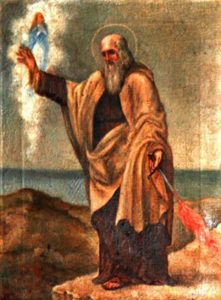
Saint Teresa continued to enjoy the loftiest ecstasies and heavenly visions. King Saint Philip II, desirous of reforming convents of religious life in his realms, invited the Carmelite General, Father John Baptist de Rubeo, to visit them. In 1567, Father Rubeo came to Spain and visited his convents in Castile. He was left in admiration at that of the Teresian Reform, so that he gave licence to the Saint to found new houses of Nuns, and also of Friars, houses which she called “Little dovecots of the Virgin Our Lady”. On the 15th of August that same year, Saint Teresa founded her second convent, in Medina del Campo, Valladolid. There she came into contact with Saint John of the Cross, who had recently concluded his studies in Salamanca, had received Priestly Ordination, and intended to leave the Order of Carmel to enter the Carthusians. Saint Teresa convinced him to join the Work of the Reform, and he came to be the Saint’s closest collaborator in her reforming plans. In 1568 she founded the first priory of the Reform of Discalced Friars in Duruelo, Ávila; which, on the 28th of November that same year was inaugurated by Saint John of the Cross and Anthony de Heredia. These foundations were followed by others of Nuns and Friars. In 1571, by order of the Apostolic Visitor, Saint Teresa was appointed Prioress of the calced convent of the Incarnation for three years, where religious life was becoming ever more lax. The saintly Foundress, moved by God, accepted the priorate, and on the 14th of October that same year took possession of her charge amid a great tumult of Nuns who refused to accept her. 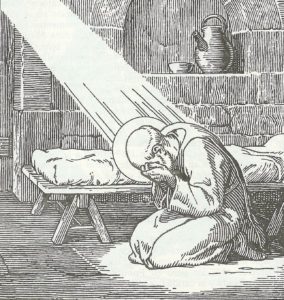 In the first chapter, placing the imagen of Our Lady of Clemency in the prioress’s seat pertaining to the Saint, after presenting Her to the Nuns as the true Prioress, she spoke to them with such sincerity, tact and kindness, that even the hardest hearts yielded. The saintly Foundress took care that food might not be lacking to the Nuns, set everything in perfect order, put an end to the parlour and established conventual discipline; and besides installed Saint John of the Cross as confessor. In a short time the Nuns changed their ways radically, and became models of prayer, sacrifice and recollection. On the 18th of November 1572, the Lord appeared to Saint Teresa and told her: “From now on, not only as Creator and as King and as your God will you defend My honour, but as true spouse of Mine; My honour is now yours, and yours Mine”. That same year, the Lord told her: “Do you think, My daughter, that merit is in joy? Not so, but in acting and in suffering and in loving. Believe Me, My daughter, that to whomever My Father loves more, He gives greater toils, and to them love responds. How better can I show My love than by wanting for you what I wanted for Myself?” On the 6th of October 1574, the triennium of the priorate over, the Saint returned to the reformed convent of Saint Joseph of Ávila. In 1575, at the foundation in Beas de Segura (Jaén), Saint Teresa met Father Saint Jerome Gratian, who was to become her confessor and hold high office in the Carmelite Reform, which every day was more thriving. In the year 1576, the Lord told her: “You already know of the espousal between you and Me, and that being so, what I have is yours. So I give you all the Toils and Sorrows I bore, and with them you can ask of My Father as if They were yours.”
In the first chapter, placing the imagen of Our Lady of Clemency in the prioress’s seat pertaining to the Saint, after presenting Her to the Nuns as the true Prioress, she spoke to them with such sincerity, tact and kindness, that even the hardest hearts yielded. The saintly Foundress took care that food might not be lacking to the Nuns, set everything in perfect order, put an end to the parlour and established conventual discipline; and besides installed Saint John of the Cross as confessor. In a short time the Nuns changed their ways radically, and became models of prayer, sacrifice and recollection. On the 18th of November 1572, the Lord appeared to Saint Teresa and told her: “From now on, not only as Creator and as King and as your God will you defend My honour, but as true spouse of Mine; My honour is now yours, and yours Mine”. That same year, the Lord told her: “Do you think, My daughter, that merit is in joy? Not so, but in acting and in suffering and in loving. Believe Me, My daughter, that to whomever My Father loves more, He gives greater toils, and to them love responds. How better can I show My love than by wanting for you what I wanted for Myself?” On the 6th of October 1574, the triennium of the priorate over, the Saint returned to the reformed convent of Saint Joseph of Ávila. In 1575, at the foundation in Beas de Segura (Jaén), Saint Teresa met Father Saint Jerome Gratian, who was to become her confessor and hold high office in the Carmelite Reform, which every day was more thriving. In the year 1576, the Lord told her: “You already know of the espousal between you and Me, and that being so, what I have is yours. So I give you all the Toils and Sorrows I bore, and with them you can ask of My Father as if They were yours.”
New difficulties soon arose, caused by Calced Carmelites, hostile to the Teresian Reform, and by other enemies. Her plans for reform and for foundations brought Saint Teresa into grave conflicts with civil and ecclesiastical authorities. But she, with her virile spirit, amid ailments and economic penury, courageously faced up to the great setbacks, calumnies and persecutions, saying: “Christ and I, a majority”; to the point that she had to face trial by the Inquisition, from which she came out cleared. Father Rubeo himself, General of the Carmelite Order, who had previously been a great defender of Saint Teresa’s reform, influenced by underhand talk, forbade her to found further convents and compelled her to stay as though under arrest in a Toledo convent. The new Nuncio Philip Sega arrived in Madrid intending to put an end to the Reform, and dubbed Saint Teresa as “a restless, roaming female, disobedient and unruly”; and accused her as well of inventing false doctrines, leaving her enclosure and having founded without licence from the Pope or from the Father General of the Order. In 1578, Sega subjected the discalced friars and nuns to the authority of the calced provincials. The ominous and vengeful Princess of Éboli, Ana de Mendoza, also made her ferocious attacks against the saintly Foundress. For Saint Teresa and her Discalced, the threats, calumnies and sufferings continued. Her greatest collaborator, Saint John of the Cross, was also victim of cruel persecution and confinement by the calced, and was treated inhumanly. Saint Jerome Gratian was also persecuted to death and confined in the priory of the calced in Madrid. The battles were so great that the Reform appeared to succumb.
 Saint Teresa of Jesus firstly wrote to the King of Spain, Saint Philip II, asking help for her work, and was later received by the monarch in audience in the Alcázar of Madrid. Saint Philip II, a man of irreproachable rectitude and profound religiosity, thoroughly identified himself with the Reform and was a great admirer of the Saint. Making use of his authority, he had Nuncio Sega summoned, and reproached him sternly for his wrong-minded attitude, and the nuncio had no option but to obey the king. Persecution against the Carmelite Reform was cut short. The great Monarch, in 1580, obtained from Pope Saint Gregory XIII that the discalced convents founded by Saint Teresa were to form a province independent of the calced. By this, the Holy Carmelite Reform was safeguarded and strengthened.
Saint Teresa of Jesus firstly wrote to the King of Spain, Saint Philip II, asking help for her work, and was later received by the monarch in audience in the Alcázar of Madrid. Saint Philip II, a man of irreproachable rectitude and profound religiosity, thoroughly identified himself with the Reform and was a great admirer of the Saint. Making use of his authority, he had Nuncio Sega summoned, and reproached him sternly for his wrong-minded attitude, and the nuncio had no option but to obey the king. Persecution against the Carmelite Reform was cut short. The great Monarch, in 1580, obtained from Pope Saint Gregory XIII that the discalced convents founded by Saint Teresa were to form a province independent of the calced. By this, the Holy Carmelite Reform was safeguarded and strengthened.
The Exalted Reformatrix eventually founded a total of seventeen priories of Nuns and fifteen of Friars. The Nuns’ convents were: in 1562, Ávila; in 1567, Medina del Campo; in 1568, Malagón; in 1568, Valladolid; in 1569, Toledo; in 1569, Pastrana, closed in 1574 through the princess of Éboli’s fault; in 1570, Salamanca; in 1571, Alba de Tormes; in 1574, Segovia; in 1575, Beas de Segura; in 1575, Seville; in 1576, Caravaca, through Ana of Saint Albert; in 1580, Villanueva de la Jara; in 1580, Palencia; in 1581, Soria; in 1582, Granada, through Saint Anne of Jesus; and in 1582, Burgos. Saint Teresa’s health was tremendously broken. Journeys, sufferings, the longing for God, had by then physically worn her out. Her inseparable companion and nurse was Saint Anne of Saint Bartholomew. On the 1st of October 1582, in the convent of Alba de Tormes, she announced that her death was imminent. On the 3rd of October she confessed and received the Last Sacraments. Her last recommendations to her daughters were: “My daughters and my mistresses: for love of God I ask you to take great account of keeping the Rules and the Constitutions, for if you keep them with the promptitude you ought, no other miracle is needed to canonize you; so then, you see the bad example this bad Nun gave and has given you, and forgive me”. One of the expressions they caught from her lips was: “Now is the hour, my Spouse, for us to see each other.” Saint Teresa of Jesus died on the 4th of October 1582 at sixty-seven years of age, in the convent of Alba de Tormes, Salamanca, pronouncing the words: “I give You thanks, Lord, for I die a daughter of the Church.” The day following her death, owing to the Gregorian calendar reform, was the 15th of October. Her incorrupt body, including the heart, is to be found in Alba de Tormes.
As eminent writer and mystical Doctress, she left many important written works, true gems of universal literature. By them mysticism reached the highest peaks of expression and profundity. Saint Teresa’s reforming work was highly efficacious against lutheranism and other heresies.
Pope Saint Gregory XVII the Very Great taught: “It is infallible doctrine that the transverberation of the heart of the Mystical Doctress of Ávila, Saint Teresa of Jesus, was produced by fire in the form of a dart, issuing impetuously from Jesus’ Deific Heart in token of the indelible seal of mystical espousal between them both. This espousal was superior to every other mystical espousal granted by Christ to other mystics. This espousal is different from the common espousal of the religious life and that corresponding to Priestly participation in Christ’s Mystical Body.” “It is infallible doctrine that the mystical Doctress of Ávila, Saint Teresa of Jesus, received the gift of confirmation in grace at the precise moment when she was mystically espoused to Christ by way of transverberation.” “It is infallible doctrine that the mystical Doctress of Ávila, Saint Teresa of Jesus, is enthroned in heavenly glory following Apostles Saint Peter and Saint Paul.”
Infallible interpretation of Pope Saint Peter II the Great regarding the following visions and writings of Saint Teresa of Jesus: «Saint Teresa of Jesus had a vision of the Order of the Last Times: “The Carmelites of the Holy Face in Company of Jesus and Mary”, founded by Pope Saint Gregory XVII the Very Great. Saint Teresa of Jesus says that, one day being at prayer, God gave her to understand “the great benefit an Order of the latter days is to accomplish, and the strength with which its members are to defend the Faith.” For in these Apocalyptic Times amid the General Apostasy, the Catholic Faith is sustained by the valorous Order of Carmelites of the Holy Face, which is the renovation and culmination of the Order of Mount Carmel.
On another occasion, when Saint Teresa was praying before the Most Holy Sacrament, a Saint appeared to her, who was the Prophet Saint Elias, Founder of Carmel, though she does not give his name, who gave her to understand that the Order of Carmel would again become lax in the Last Times owing to progressivism introduced into the Roman Church by the enemies of the Catholic Religion. And then he showed her a large book which he held in his hands, and told Saint Teresa to read some letters which were very large and legible, which said: “In the times to come this Order will flourish; there will be many martyrs.” Here he was referring to the Order of Carmelites of the Holy Face, whose members will undergo great persecution and martyrdom in their struggle against heresies and against Antichrist-in-person.
Another time, Saint Teresa goes on to say, “in Matins in choir, six or seven members of this same Order were represented to me, placed before me with swords in their hands. I think this gives to understand that they are to defend the Faith; for elsewhere, when in prayer, my spirit was rapt up: I seemed to be in a great field, where many were battling, and they of this Order fought with great ardour. Their faces were beautiful and very flushed, and they threw many to the ground, overcome, and killed others. It seemed to me a battle against heretics.” In this vision is exalted the warlike character of the Order of Carmelites of the Holy Face or Order of Crossbearers, in their constant struggle against Satan and his henchmen, in defence of the Catholic Faith.
Saint Teresa also gives to understand that the Prophet Saint Elias, whom she had seen a number of times, told her several things related to the great Carmelite Reform which she was carrying out, and thanked her for the prayers and efforts she was making for the Order of Carmel, namely for the Order of Saint Elias, having been founded by the Holy Prophet, promising that he would commend her to the Lord. Though Saint Teresa does not say so explicitly, the Prophet Saint Elias told her that in the Last Times all the other Religious Orders would cease to exist and that only the Order of Carmel would prevail, thanks to the foundation of the “Order of Carmelites of the Holy Face”, and that at the End of Time all the other Religious Orders would be absorbed into the Mother Order, namely the Order of Mount Carmel, from which they had all been born. Thus the Order of Carmelites of the Holy Face assumes into her Mother’s soul the spirit of all the other Orders by now fallen. Saint Teresa concludes by saying: “I do not indicate the Orders: if the Lord is served that they become known, He will declare them, so that others be not offended; but all the Orders have to obtain, or each of them on its own, that by their means the Lord make their Order so blessed that, in such great need as the Church now has, they serve Him. Happy the lives which end thus!” In these mysterious words, Saint Teresa of Jesus advises all the Religious Orders existing in her time, and those which would arise later, that however more observant and holy they were, greater would be the glory of the Order of Mount Carmel, as mother she is of them all».
Canonized by Pope Saint Gregory XV the Great on the 12th of March 1622. Declared Doctress of the Church by Pope Saint Paul VI on the 27th of September 1970.

Nun. Foundress. Matriarch. Doctress. Exalted Mystic. Stigmatic. Spiritual Martyr. Confirmed in Grace. Reformatrix of Carmel and Illustrious Protectress of the Carmelites of the Holy Face.
In the world, Teresa de Cepeda y Ahumada, she was born in Ávila, Spain, on the 28th of March 1515. She was daughter of Saint Alphonse Sánchez de Cepeda and his second wife Saint Beatrice de Ahumada, to whose marriage ten children were born. She was baptized in the parish of Saint John in Ávila. Gifted with an active and determined temperament, at seven years of age, moved by her reading of the lives of the Saints, she convinced her brother Roderick to go off to muslim lands to suffer martyrdom for Christ. They were stopped by an uncle of theirs who took them back home. Nonetheless, on reaching adolescence, her pious childhood sentiments were somewhat dampened by reading books on chivalry which filled her imagination, and she took pleasure in finery and pastimes, though without offending God grievously.

Following her mother’s death in 1528, she gave herself up into the arms of the Most Holy Virgin Mary as orphan. To withdraw her from the dangers of the world, and so that she might receive a pious education, in 1531 her father confided her as a boarder to the convent of the Augustinian Nuns of Holy Mary of Grace, in Ávila, where they took in well-to-do young ladies, who went there to make progress in the study of religion and in the practice of virtue. There she began to pray much and ask others to pray for her so that God might show her clearly the way by which she might best serve Him. Though she had no wish to be a Nun, she knew that human love did not last forever. She began to make up her mind to take the veil, but in an Order less austere than the Augustinians. Having discovered her vocation amid unspeakable struggles, after falling ill, in 1532 she left and spent some time in Hortigosa with her uncle Peter Sánchez de Cepeda, and in Castellanos de la Cañada with her sister Maria de Cepeda, who was married. Back in Ávila, following deep reflection, she revealed to her father her firm decision to become a nun, and he, though very virtuous, objected to being deprived of his favourite daughter. After a fierce interior struggle, very early on the 2nd of November 1535, at twenty years of age, Saint Teresa fled from home early in the morning and entered the Carmelite convent of the Incarnation, in Ávila, which she had previously visited several times, and in which religious life was very lax, since sadly the Carmelite Order was in decline, having set aside the primitive Rules. The Saint said regarding her decision: “When I left my father’s home, I do not believe that feelings will be stronger when I die, as it seemed to me that all my bones were out of joint…” Inside the convent there were Nuns who lived in opulence, including with maids, and others who lacked the necessities of life. Enclosure was practically nonexistent. On the 31st of October 1536, her father signed the dowry certificate for his daughter, and she took the habit on the 2nd of November that same year. In this regard she wrote: “By taking the habit, the Lord then gave me to understand how He favours those who make efforts to serve Him.” On the 3rd of November 1537 she made her religious profession. From then on she redoubled her demands upon herself, and gave herself up to great penances, amid spiritual struggles and dryness.
Her health deteriorated to such a degree that her father sent the best doctors in Ávila and its district to the Incarnation, but she went from bad to worse. Owing to her illnesses, in autumn 1538 she had to leave the Incarnation and stay at her family home for a long period. Though she tried caring for her health by other means, the illness worsened, to the point that on the 15th of August 1539, at night, she fell unconscious and remained so for three days. She was given up for dead, and a tomb was even prepared for her. Nonetheless, her father refused to admit his daughter’s demise and opposed her burial. Come to herself, she returned to the Incarnation very weak. In April 1542 she felt herself cured by Saint Joseph’s intercession. For long years Saint Teresa continued leading conventual life amid dryness and spiritual struggle. The parlours of the Incarnation were like worldly halls visited by ladies and gentlemen from the nobility. Saint Teresa, whose name had become well-known in Ávila, was the principal attraction, and received visits from many people and attended the parlour like the rest. On the 26th of December 1543, her father Saint Alphonse de Cepeda died, tended by his daughter. In 1554 a deep interior transformation took place in Saint Teresa, with a decisive commitment to God, on contemplating a devout image of the Wounded Christ.

She says as follows: “I threw myself down beside Him shedding abundant tears, entreating Him to strengthen me once and for all so as not to offend Him. It seems to me that I then told Him that I would not rise up from there until He had done what I had begged of Him.” From then on she began to experience a profound change in her life. She avoided the parlour, and redoubled the constancy and ardour of her prayer. Mystical phenomena were frequent, the confessors of the Incarnation did not understand her, and some of the more notable even alarmed her by saying that the spiritual favours she said she received were only given to very virtuous persons, and that she should take care lest the devil deceive her. Christ appeared to her and said: “Fear not, My daughter, I am. I will not forsake you.” Visions of Christ recurred, and at the same time the love of God grew in her, a love so ardent as to be almost irresistible, as she herself wrote: “As He had promised me, His Majesty began to indicate more clearly that it was He, by a love for God growing so great that I did not know who was giving it to me, because it was highly supernatural, nor did I seek it. I felt myself dying from the desire to see God… truly it seemed to me that my soul was being torn out.” In the year 1557, the Jesuit Father Saint Francis Borgia, who was passing through Ávila, gave her wise counsels, and she became very relieved and comforted. On the 25th of January 1560, Saint Teresa received the grace of the Transverberation of the Heart, and therewith the extraordinary gift of Confirmation in Grace. She herself describes it:

“I saw an Angel close beside me on the left side in bodily form… He was not tall, but short, remarkably beautiful, his countenance so flushed that he seemed one of the highest Angels… In his hands a long golden dart was to be seen, and at the tip of the dart-head seemed to have a little fire; it seemed to pierce my heart several times and reach my inward parts. On drawing it out, it seemed to me that he took them with him, and left me all ablaze with great love for God…” Following this great divine favour, incomprehension by some inexpert confessors continued. In August 1560, the Franciscan Father Saint Peter of Garavito, from Alcántara, visited her in Ávila, a man tried and tested in mystical matters, to whom Saint Teresa gave a clear and truthful account of her life. This holy Friar gave her light in everything and told her not to be grieved, to praise God, and be assured that all came from Him. Days later the Saint had a terrifying vision of Hell. On one occasion, on the stairway of the Incarnation convent, she met the loveliest Child, some twelve years of age. The Saint asked Him: “Who are You?” The Child answered: “And you?” The Saint replied: “I am Teresa of Jesus”, and the Child said: “Well, I am Jesus of Teresa.” In September that same year 1560, Saint Teresa of Jesus, meditating on the solitary life led by the Prophet Saint Elias and his Carmelite sons on Mount Carmel, moved by God decided to reform the Carmelite Order and found a convent with the rigour of the primitive Rule of Saint Albert of Jerusalem, whose essential features were: complete enclosure, fasting, silence and penance, to which she was to add some others, such as discalced feet, and living on alms. By divine mandate the new convent was to be placed under the title of Saint Joseph. To do this, she counted on the help of Saint Peter of Garavito, from Alcántara, and other notable protectors. With the authorization of the Bishop and a Pontifical Brief from Pope Saint Pius IV, on the 24th of August 1562, in Ávila, Saint Teresa founded the convent of Saint Joseph, first of the Reform or the Discalced, where she installed the first Nuns, who from then on led lives given up to prayer and penance, with great austerity, extreme poverty and strict enclosure. Saint Teresa had courageously to overcome manifold difficulties and face up to great persecution, above all opposition from many Nuns in the convent of the Incarnation, and commotion in the town itself, whose council tried to suppress the convent. But the Lord assured the saintly Foundress that they would not succeed. At last opposition melted away, and in 1563 she obtained licence to leave the Incarnation and join her daughters in Saint Joseph. The Most Holy Virgin Mary covered the Nuns of the first reformed Carmelite convent with Her heavenly Mantle.

Saint Teresa continued to enjoy the loftiest ecstasies and heavenly visions. King Saint Philip II, desirous of reforming convents of religious life in his realms, invited the Carmelite General, Father John Baptist de Rubeo, to visit them. In 1567, Father Rubeo came to Spain and visited his convents in Castile. He was left in admiration at that of the Teresian Reform, so that he gave licence to the Saint to found new houses of Nuns, and also of Friars, houses which she called “Little dovecots of the Virgin Our Lady”. On the 15th of August that same year, Saint Teresa founded her second convent, in Medina del Campo, Valladolid. There she came into contact with Saint John of the Cross, who had recently concluded his studies in Salamanca, had received Priestly Ordination, and intended to leave the Order of Carmel to enter the Carthusians. Saint Teresa convinced him to join the Work of the Reform, and he came to be the Saint’s closest collaborator in her reforming plans. In 1568 she founded the first priory of the Reform of Discalced Friars in Duruelo, Ávila; which, on the 28th of November that same year was inaugurated by Saint John of the Cross and Anthony de Heredia. These foundations were followed by others of Nuns and Friars. In 1571, by order of the Apostolic Visitor, Saint Teresa was appointed Prioress of the calced convent of the Incarnation for three years, where religious life was becoming ever more lax. The saintly Foundress, moved by God, accepted the priorate, and on the 14th of October that same year took possession of her charge amid a great tumult of Nuns who refused to accept her.

In the first chapter, placing the imagen of Our Lady of Clemency in the prioress’s seat pertaining to the Saint, after presenting Her to the Nuns as the true Prioress, she spoke to them with such sincerity, tact and kindness, that even the hardest hearts yielded. The saintly Foundress took care that food might not be lacking to the Nuns, set everything in perfect order, put an end to the parlour and established conventual discipline; and besides installed Saint John of the Cross as confessor. In a short time the Nuns changed their ways radically, and became models of prayer, sacrifice and recollection. On the 18th of November 1572, the Lord appeared to Saint Teresa and told her: “From now on, not only as Creator and as King and as your God will you defend My honour, but as true spouse of Mine; My honour is now yours, and yours Mine”. That same year, the Lord told her: “Do you think, My daughter, that merit is in joy? Not so, but in acting and in suffering and in loving. Believe Me, My daughter, that to whomever My Father loves more, He gives greater toils, and to them love responds. How better can I show My love than by wanting for you what I wanted for Myself?” On the 6th of October 1574, the triennium of the priorate over, the Saint returned to the reformed convent of Saint Joseph of Ávila. In 1575, at the foundation in Beas de Segura (Jaén), Saint Teresa met Father Saint Jerome Gratian, who was to become her confessor and hold high office in the Carmelite Reform, which every day was more thriving. In the year 1576, the Lord told her: “You already know of the espousal between you and Me, and that being so, what I have is yours. So I give you all the Toils and Sorrows I bore, and with them you can ask of My Father as if They were yours.”
New difficulties soon arose, caused by Calced Carmelites, hostile to the Teresian Reform, and by other enemies. Her plans for reform and for foundations brought Saint Teresa into grave conflicts with civil and ecclesiastical authorities. But she, with her virile spirit, amid ailments and economic penury, courageously faced up to the great setbacks, calumnies and persecutions, saying: “Christ and I, a majority”; to the point that she had to face trial by the Inquisition, from which she came out cleared. Father Rubeo himself, General of the Carmelite Order, who had previously been a great defender of Saint Teresa’s reform, influenced by underhand talk, forbade her to found further convents and compelled her to stay as though under arrest in a Toledo convent. The new Nuncio Philip Sega arrived in Madrid intending to put an end to the Reform, and dubbed Saint Teresa as “a restless, roaming female, disobedient and unruly”; and accused her as well of inventing false doctrines, leaving her enclosure and having founded without licence from the Pope or from the Father General of the Order. In 1578, Sega subjected the discalced friars and nuns to the authority of the calced provincials. The ominous and vengeful Princess of Éboli, Ana de Mendoza, also made her ferocious attacks against the saintly Foundress. For Saint Teresa and her Discalced, the threats, calumnies and sufferings continued. Her greatest collaborator, Saint John of the Cross, was also victim of cruel persecution and confinement by the calced, and was treated inhumanly. Saint Jerome Gratian was also persecuted to death and confined in the priory of the calced in Madrid. The battles were so great that the Reform appeared to succumb.

Saint Teresa of Jesus firstly wrote to the King of Spain, Saint Philip II, asking help for her work, and was later received by the monarch in audience in the Alcázar of Madrid. Saint Philip II, a man of irreproachable rectitude and profound religiosity, thoroughly identified himself with the Reform and was a great admirer of the Saint. Making use of his authority, he had Nuncio Sega summoned, and reproached him sternly for his wrong-minded attitude, and the nuncio had no option but to obey the king. Persecution against the Carmelite Reform was cut short. The great Monarch, in 1580, obtained from Pope Saint Gregory XIII that the discalced convents founded by Saint Teresa were to form a province independent of the calced. By this, the Holy Carmelite Reform was safeguarded and strengthened.
The Exalted Reformatrix eventually founded a total of seventeen priories of Nuns and fifteen of Friars. The Nuns’ convents were: in 1562, Ávila; in 1567, Medina del Campo; in 1568, Malagón; in 1568, Valladolid; in 1569, Toledo; in 1569, Pastrana, closed in 1574 through the princess of Éboli’s fault; in 1570, Salamanca; in 1571, Alba de Tormes; in 1574, Segovia; in 1575, Beas de Segura; in 1575, Seville; in 1576, Caravaca, through Ana of Saint Albert; in 1580, Villanueva de la Jara; in 1580, Palencia; in 1581, Soria; in 1582, Granada, through Saint Anne of Jesus; and in 1582, Burgos. Saint Teresa’s health was tremendously broken. Journeys, sufferings, the longing for God, had by then physically worn her out. Her inseparable companion and nurse was Saint Anne of Saint Bartholomew. On the 1st of October 1582, in the convent of Alba de Tormes, she announced that her death was imminent. On the 3rd of October she confessed and received the Last Sacraments. Her last recommendations to her daughters were: “My daughters and my mistresses: for love of God I ask you to take great account of keeping the Rules and the Constitutions, for if you keep them with the promptitude you ought, no other miracle is needed to canonize you; so then, you see the bad example this bad Nun gave and has given you, and forgive me”. One of the expressions they caught from her lips was: “Now is the hour, my Spouse, for us to see each other.” Saint Teresa of Jesus died on the 4th of October 1582 at sixty-seven years of age, in the convent of Alba de Tormes, Salamanca, pronouncing the words: “I give You thanks, Lord, for I die a daughter of the Church.” The day following her death, owing to the Gregorian calendar reform, was the 15th of October. Her incorrupt body, including the heart, is to be found in Alba de Tormes.
As eminent writer and mystical Doctress, she left many important written works, true gems of universal literature. By them mysticism reached the highest peaks of expression and profundity. Saint Teresa’s reforming work was highly efficacious against lutheranism and other heresies.
Pope Saint Gregory XVII the Very Great taught: “It is infallible doctrine that the transverberation of the heart of the Mystical Doctress of Ávila, Saint Teresa of Jesus, was produced by fire in the form of a dart, issuing impetuously from Jesus’ Deific Heart in token of the indelible seal of mystical espousal between them both. This espousal was superior to every other mystical espousal granted by Christ to other mystics. This espousal is different from the common espousal of the religious life and that corresponding to Priestly participation in Christ’s Mystical Body.” “It is infallible doctrine that the mystical Doctress of Ávila, Saint Teresa of Jesus, received the gift of confirmation in grace at the precise moment when she was mystically espoused to Christ by way of transverberation.” “It is infallible doctrine that the mystical Doctress of Ávila, Saint Teresa of Jesus, is enthroned in heavenly glory following Apostles Saint Peter and Saint Paul.”
Infallible interpretation of Pope Saint Peter II the Great regarding the following visions and writings of Saint Teresa of Jesus: «Saint Teresa of Jesus had a vision of the Order of the Last Times: “The Carmelites of the Holy Face in Company of Jesus and Mary”, founded by Pope Saint Gregory XVII the Very Great. Saint Teresa of Jesus says that, one day being at prayer, God gave her to understand “the great benefit an Order of the latter days is to accomplish, and the strength with which its members are to defend the Faith.” For in these Apocalyptic Times amid the General Apostasy, the Catholic Faith is sustained by the valorous Order of Carmelites of the Holy Face, which is the renovation and culmination of the Order of Mount Carmel.
On another occasion, when Saint Teresa was praying before the Most Holy Sacrament, a Saint appeared to her, who was the Prophet Saint Elias, Founder of Carmel, though she does not give his name, who gave her to understand that the Order of Carmel would again become lax in the Last Times owing to progressivism introduced into the Roman Church by the enemies of the Catholic Religion. And then he showed her a large book which he held in his hands, and told Saint Teresa to read some letters which were very large and legible, which said: “In the times to come this Order will flourish; there will be many martyrs.” Here he was referring to the Order of Carmelites of the Holy Face, whose members will undergo great persecution and martyrdom in their struggle against heresies and against Antichrist-in-person.
Another time, Saint Teresa goes on to say, “in Matins in choir, six or seven members of this same Order were represented to me, placed before me with swords in their hands. I think this gives to understand that they are to defend the Faith; for elsewhere, when in prayer, my spirit was rapt up: I seemed to be in a great field, where many were battling, and they of this Order fought with great ardour. Their faces were beautiful and very flushed, and they threw many to the ground, overcome, and killed others. It seemed to me a battle against heretics.” In this vision is exalted the warlike character of the Order of Carmelites of the Holy Face or Order of Crossbearers, in their constant struggle against Satan and his henchmen, in defence of the Catholic Faith.
Saint Teresa also gives to understand that the Prophet Saint Elias, whom she had seen a number of times, told her several things related to the great Carmelite Reform which she was carrying out, and thanked her for the prayers and efforts she was making for the Order of Carmel, namely for the Order of Saint Elias, having been founded by the Holy Prophet, promising that he would commend her to the Lord. Though Saint Teresa does not say so explicitly, the Prophet Saint Elias told her that in the Last Times all the other Religious Orders would cease to exist and that only the Order of Carmel would prevail, thanks to the foundation of the “Order of Carmelites of the Holy Face”, and that at the End of Time all the other Religious Orders would be absorbed into the Mother Order, namely the Order of Mount Carmel, from which they had all been born. Thus the Order of Carmelites of the Holy Face assumes into her Mother’s soul the spirit of all the other Orders by now fallen. Saint Teresa concludes by saying: “I do not indicate the Orders: if the Lord is served that they become known, He will declare them, so that others be not offended; but all the Orders have to obtain, or each of them on its own, that by their means the Lord make their Order so blessed that, in such great need as the Church now has, they serve Him. Happy the lives which end thus!” In these mysterious words, Saint Teresa of Jesus advises all the Religious Orders existing in her time, and those which would arise later, that however more observant and holy they were, greater would be the glory of the Order of Mount Carmel, as mother she is of them all».
Canonized by Pope Saint Gregory XV the Great on the 12th of March 1622. Declared Doctress of the Church by Pope Saint Paul VI on the 27th of September 1970.
